Where Does the Best White Tea Come From?

White teas have only gotten more and more popular with each year we’ve been in the tea business. Amid western marketing that promotes a wide range of health benefits and the modern affluence of Chinese connoisseurs, the demand for traditional white tea has skyrocketed, and continues to increase with each new harvest. As with most “famous” teas, this demand long ago outpaced the supply from the traditional farms that earned the famed reputation in the first place. Today, many white teas are grown outside the traditional region of Fuding County, Fujian, but purists consider these to be imitations, even if they're made with traditional crafting methods.
Though almost all tea styles are associated with a specific region of origin, most are defined primarily by their crafting methods. Distinctive crafting techniques like the quick roasting of green tea, the rolling of oolong leaves, or the full oxidation of black tea are often adapted in new regions, which sometimes go on to develop their own styles and reputations within the wider tea category. (Taiwanese black teas are a good example.) White tea, however, only undergoes the simplest of processing steps, making terroir all the more important to the final flavor of the brew.
Essentially, the effects of terroir boil down to two factors - the unique composition of the region’s soil, and the local climate. In the production of white tea, the most important of these is the climate. The mountainous country in northern Fujian offers a temperate environment for the tea bush, which gives the plant plenty of time to store natural sugars and complex flavor compounds during a slow growth process. As with many other styles of tea, examples grown at high elevation are the most sought after, since they have the slowest growth rates.
In other, non-traditional regions, some high elevation farms come close to achieving similar climate conditions, and many produce perfectly drinkable white teas. Darjeeling, in India, is a good example. But experienced farmers rarely attempt to transplant traditional white tea varieties like Da Bai, preferring instead to use local varieties that are better suited to their soil conditions. And well known regions like Darjeeling are usually more focused on meeting the demand for their own sought after styles than devoting valuable farmland to experimental white teas.
More common are new white tea farms in areas of central or southern China, like Yunnan Province. With much warmer weather on average, these tea plants get more sun exposure and grow more quickly, resulting in higher crop yields and lower prices, but also less of the natural sweetness and flavor complexity found in white teas from Fuding County. Rather than emphasize the factors that make these new teas distinct, they are typically sold under traditional white tea names, despite using non-traditional terroir and varieties. These quick-growing imitations are sometimes identifiable by their larger leaf size, but it’s fair to say if the vendor can’t tell you their origin, they’re probably not from Fuding County.
For all these reasons, we often refer to white tea as the 'Champagne' of the tea world. So much of the traditional quality of flavor depends on the tea’s terroir and variety that we only source white teas from Fuding County, despite the premium prices they demand. While sparkling wines abound, there’s only one Champagne.
Where does your favorite white tea come from? Tell us about it in the comments!
Sign up for our newsletter to get blog updates in your inbox!





Comments on this post (3)
Amazing blog, very interesting and helpful. Thanks for sharing.
— Halmari Tea
Hi Margaret,
Yes, our traditional white teas come from organic farms in Fuding County.
Amy
— Amy Covey
Hello,
Is your white tea organic?
MH
— Margaret Hollenbeck